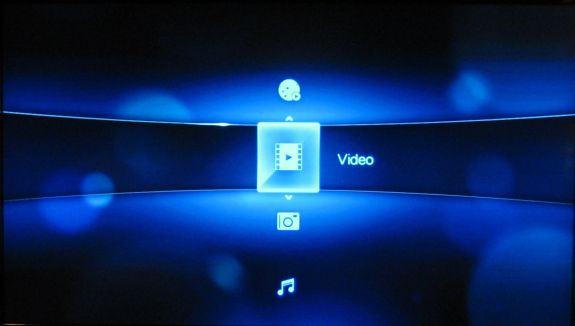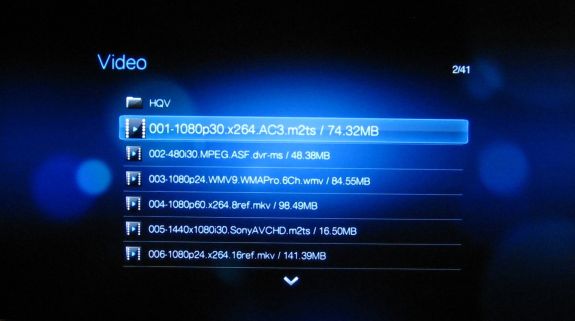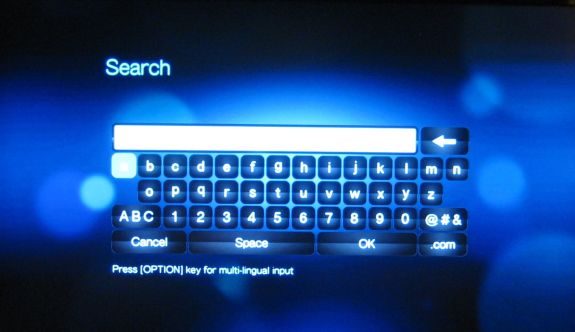WD TV Live Plus: Western Digital's Latest Media Player Reviewed
by Cameron Butterfield on July 29, 2010 1:00 AM EST- Posted in
- Home Theater
- Media Streamer
- WD
- WD TV Live Plus
The WD TV Live Plus is easy to setup, especially if you are utilizing the HDMI port that is capable of carrying all your audio and video signals at once over a single cable. Getting the WD TV Live Plus to lay flat after plugging in a heavy duty cable can be a bit of a challenge, as the weight and tension of the cable seems to make it flip to the side until you play with it for a while, but you can hardly blame WD for making such a slim and light device. However If you do purchase this device, you may want to invest in a roll of velcro or double sided tape to keep it in place.
Once seated and connected, the WD TV boots up quickly and you are provided with dark and light blue color scheme menu system that is very easily controled by using the arrow keys and a back, forward (OK) control scheme that is very reminiscent to the PSP, or PS3 menu system or Windows 7 Media Center. Western Digital did a good job of making the UI on this device familiar and easy to use for end users, they also have provided a screensaver mode that automatically blanks the screen and displays a WD logo in random areas.

When a USB device containing compatible media files is first inserted, the media library compilation process begins (if it is enabled), and media is sorted out into their respective media categories, namely Music, Video, or Photo. This feature allows you to use the search functionality rather than simply browsing around inside folders to find your media. In addition, the WD TV Live’s menu system provides file organization features as well, allowing you to move and copy your media and folders around on your connected storage devices. These are welcome features and gives the WD TV somewhat of a unique advantage over other media players that do not have these types of organizational features.
You can browse each of the sections (Video, Pictures and Music) using different viewing modes; thumbnails or list. The thumbnail view will show images for folders that have a FOLDER.JPG file within the folder, MP3 files with embedded artwork, photo files themselves, and mp4 files with user generated thumbnail images. This viewing mode works well for Music and Photos, but can be a troublesome viewing mode for videos. Since most videos do not have embedded images, the end result of viewing a folder full of videos is that you are unable to distinguish the videos from each other very easily, and when scrolling through the list of videos, the default thumbnail image is the same which creates a static visual effect where you can’t tell if you are actually scrolling through the video files or not. Sticking to the list or preview view on the video menu is recommended unless you are only viewing mp4 files that you have already generated the thumbnails for.


Western Digital also deserves some recognition for their efforts in providing a comprehensive manual for the WD TV Live Plus product. I was impressed with the level of detail and instruction on how to perform tasks on the device. Each step was outlined clearly with not only instructions but also many screenshots outlining each step and showing the action taking place on screen. This attention to detail makes a big difference in the user’s learning curve as it is much easier to translate screenshots into actual device usage rather than just text on a blank white page.










81 Comments
View All Comments
Decaff - Thursday, July 29, 2010 - link
I definately second this.Most of the commentaries I've seen around point to the PlayON being a far better player, though some people claim the WDTV to be better, but doesn't back it up.
Also, the Popcorn boxes are often regarded as being superior (probably due to the higher pricetag), but I haven't seen any solid confirmation of it anywhere.
So keep up the good work. I'm loving these articles.
jo-82 - Thursday, July 29, 2010 - link
Why would i want to let my normal machine run all the time? If i use a USB-attached one i have the mess auf more Cables and an additional device.Dear WD: Put a 2,5" Drivebay (Hotswappable would be nice) inside and we have a deal. Especially as a Device for Parents und and Friends...
probedb - Thursday, July 29, 2010 - link
Some of us have these things called fileservers or NAS boxes. If you want an internal drive why are you even looking at this as that's not what it's for???dvinnen - Thursday, July 29, 2010 - link
These type devices are geared toward people who have media servers (i currently use a 7 year old machine running linux and a ton of storage and it works great). Also to get you to purchase a WD external HD.Internal storage wouldn't work unless they added NAS functionality to it. Hot swapping drives to put media on it and bring it back to the player just sounds like a bad idea.
saiga6360 - Friday, July 30, 2010 - link
Did you happen to see the price tag? You want something like, you will have to pay more for like a Popcorn Hour or a Dune.Finite Loop - Thursday, July 29, 2010 - link
I had been looking for the WD TV Live, but it was sold out everywhere and nobody had any backorders for it. I went with the AC Ryan Playon HD mini.It would have been nice if the article discussed playback over the LAN connection. The AC Ryan performs well over its (100Mb) LAN connection except for 1080p content where fast action scenes may exhibit block-effects. The only content the AC Ryan doesn't seem to play (whether from LAN or USB) is stereoscopic video which causes the player to freeze.
I was hoping this WD "Plus" version would have a gigabit connection. Without gigabit, the increase in price in comparison to the previous version doesn't seem to be justified. Additionally, the AC Ryan comes with an HDMI cable which I would have had to purchase separately had I gone with a WD TV Live model.
It's interesting the article mentions the chip(s) in the WD TV Live Plus however a comparison with chips used in other devices would be appreciated. Why does this device require 1Gigabyte of memory while the AC Ryan mini operates with only 128MB? What's the difference between the video decoding chip in this player and other players?
cbutters - Thursday, July 29, 2010 - link
You can get the WD TV Live Plus for 119 at newegg with a free 8GB thumb drive.I'm not entirely sure that gigabit is an important feature here, with bluray video streams maxing out at 40mbps and averaging less than 30, there seems to be little benefit of increasing the 100mbps connection to 1000 as the bandwidth would go unused. However this is something that we hope to examine further in future articles.
Saltbread - Thursday, July 29, 2010 - link
I'm assuming that the Core 100 refers to the Asrock product reviewed before and the column should actually be labled Live Plus or something like that. My apologies if I am incorrect.ganeshts - Thursday, July 29, 2010 - link
This has been fixed. Thanks for pointing out.ned14 - Thursday, July 29, 2010 - link
These low end media boxes mainly come with one of two chipsets: Sigma and Realtek with the former being more expensive. The problem isn't the hardware, it's more the manufacturer supplied firmware where the Sigma one is good, whereas the Realtek one was written by incompetent chimpanzees. Anyone who has used both types of box will know exactly what I mean.There is a brand new third option though - the Amlogic chipset. Its firmware is spartan, but due to its simplicity is seems to "just work" and it looks better than the Realtek's but not as good as the Sigma. The specs of the Amlogic I bought is detailed here at http://www.iboum.com/pr/nation2.php.
My first problem with the WDTV Live, as with anything costing more than US$70, is that for that price it really ought to have an internal drive bay so you don't have to faff around with external USB drive solutions. My second problem is with anything costing more than US$100 when for less or even not much more you can pick up a second hand P3 based quiet computer off ebay or a second hand games console both of which are far better media playing solutions. After all, Boxee and/or XBMC can be downloaded and installed on most things, so a DIY solution is often better here.
The only remaining argument is that these boxes are small and easily transportable e.g. to a friend's house in a way that PCs and game consoles are not. And here's my third problem with these boxes: top end smartphones are increasingly able to serve content either through HDMI or DNLA or both, and you can't beat a phone for portability.
Now if you can pick up a tiny light box for US$70 AND it has an internal drive bay AND it can play off of a DNLA server such as a phone - e.g. the Amlogic box I bought - then you might be on to something because it can act as a simple TV driver for media living elsewhere while still having the flexibility to act as a cheap NAS box too if desired. And what few bugs it has in its firmware have been fixed quickly as they seem to be operating a quarterly firmware release schedule. Personally I have been pleasantly surprised considering the price.
Oh, and it plays RMVB just fine. I have a huge collection of South Park in RMVB, and while they're a little blocky on my 1080p TV due to the low bitrate that is hardly the player's fault!
Cheers,
Niall